Parallel & Series Circuit Notes/Activities |
Answer questions in complete sentences, when possible. |
| Click here for a formatted Acrobat file version of this page. |
Sort your light bulbs according to brightness. To do this connect the ends of each bulb to a pair of batteries. Attach a piece of tape to one of the wires on each BRIGHT bulb.

Take the brighter and dimmer light bulbs to the “Ohm Meter” in the room. Attach the leads of the meter to the ends of the wire on the light bulb.

1 Resistance of the “dimmer” bulbs:  (2) Resistance of the “brighter” bulbs:
(2) Resistance of the “brighter” bulbs: 
3 Each bulb has the same voltage across it when you tested it. Use ohms law to try to explain why the brighter bulb is brighter.







Take a bright light bulb and connect to two batteries as shown below.

Attach a “Zenor” diode to one of the ends of the light bulb. The zenor diode is a small black cylinder on a wire. It has a thin silver band around the circumference at one end. It does not matter which end the diode is attached to or which side of the diode faces the light bulb. Repeat the steps above.

4 What function does the diode perform to the current flow?



5 How is a zenor diode is used in battery powered device like a discman™ or TV remote?


Take the brighter light bulbs and keep adding batteries until the bulb burns out. Combine your resources with another group. Burn out ONLY one light bulb. Put an “X” on the burnt out bulb’s tape.

6 Describe what you see happening to the light bulb as more and more batteries are added.



7 How many volts did it take to burn out the light bulb?


Elsewhere in the classroom is a burnt out light bulb, it is under a 30X magnifying loop. Take a look at and draw what you see inside the bulb.

The schematic diagram for the circuit above with 3 batteries looks like this...
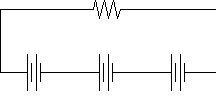
9 A light bulb is really a resistor that glows. Draw a box around the schematic symbol that stands for the light bulb in your circuit.
All circuits must make a loop like the diagram on the previous page. A loop means the one wire must connect to a positive end of a battery while the other end connects to a negative end. You must have a difference in voltage.
Make each circuit below with the bright light bulbs. (The actual length of the wire in between the bulbs will not affect your results to any noticeable measure.)

10. The batteries are connected in series and light bulbs are all connected in series. Draw a circuit for each diagram above in the space below.
11. What did you notice happening to the brightness of each light bulb as you added more and more light bulbs in series?






12. The brightness in each light bulb is directly proportional to the voltage delivered to the light bulb -because each bulb has the same resistance. Explain why each light bulbs’ brightness is affected the way it is was when they were added in SERIES in terms of what we have recently studied in electricity.












Make the following circuits.
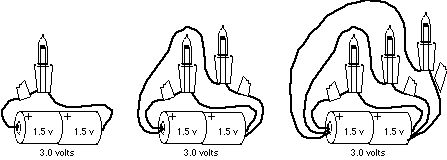
13 Describe what you see happening to the light bulb as more light bulbs are added.





Make the circuits below.

14. What is the effect on the bulbs’ brightness when the extra 2 pieces of wire are added?




15 The brightness in each light bulb is directly proportional to the voltage delivered to the light bulb -because each bulb has the same resistance. Explain why each light bulbs’ brightness is affected the way it is was when they were added in PARALLEL in terms of what we have recently studied in electricity.












16 In the space below, draw the circuit for the picture.
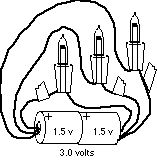
Make the two circuits shown below. Rank the brightness of each circuit from 1 to 3. by writing a number next to the circuit. The brightest circuit is a “1.”
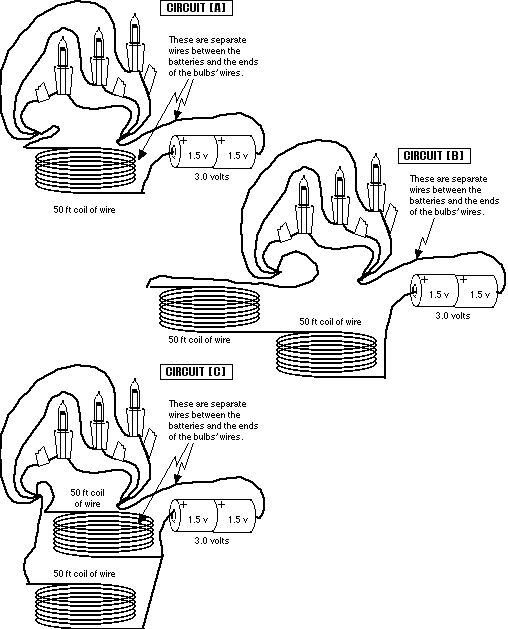
17 What is the effect of making the length of wire between the batteries and the light bulbs longer?




18 Why do you think this may be happening?




19. What is the effect of running two simultaneous sets of wires, Circuit [ C ], between the batteries and the light bulbs?




20. Why do you think this may be happening?




Read the questions below and make the following circuits.

21. Circle the light bulbs that light up on the pictures above.
22. Current flows through the wires. Current delivers the charges that carry the voltage to the electrical pieces. Describe why you got the results above on both sets of circuits in terms of current and voltage.











23. How do you think the lights and outlets are wired in your home. Are they in series or parallel? Explain your answer.











24. Draw a circuit for the picture below in the space under the picture.

22 What do you think will happen and why when you replace the #3 light bulb with a dimmer light bulb?







Replace light bulb #3 with a dim bulb.
25 Was you prediction correct? If not what was different and explain why you got the results you got.














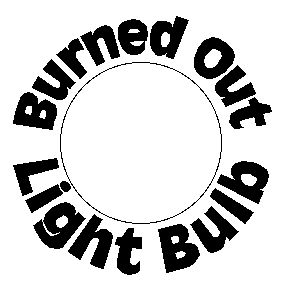
Look at the burned out light bulb in the class. In the circle above, draw what you see. Using your drawing as evidence explain why a burned out light bulb stops working.
by Tony Wayne ...(If you are a teacher, please feel free to use these resources in your teaching.)
The owner of this website does not collect cookies when the site is visited. However, this site uses and or embeds Adobe, Apple, GoDaddy, Google, and YouTube products. These companies collect cookies when their producs are used on my pages. Click here to go to them to find out more about how they use their cookies. If you do not agree with any of their policies then leave this site now.